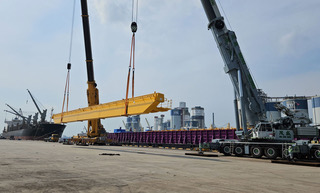
Introduction:
A double girder overhead crane is an example of a crane system designed to carry medium and heavy-duty loads in operational environments. This case study describes the successful transportation of overhead crane parts manufactured in China up to a private jetty located in Palembang, Indonesia.
Background:
Access World was engaged by their client to receive a shipment of Overhead Crane Girder parts exported from China at a suitable international port for transhipment to the receiver’s private jetty in Indonesia. A barge charter was arranged to transport cargo to the final destination via ship-to-ship over-side transfer.
Access World Singapore worked in collaboration with Access World Indonesia to carefully evaluate the most cost-effective and operationally feasible logistics solution.
Challenges:
The first challenge faced for this project was during the cargo assessment stage. The main girders were overlength at 35.5 meters long, with irregular top surfaces. Any logistics movement of these main girders would require tandem lifting using suitable crane equipment i.e. when a load is lifted using 2 devices simultaneously.
Given the cargo dimensions, Access World had to carefully assess the necessary equipment required during the different stages, and propose which transhipment port option (Jurong Port, Singapore or Boom Baru Port, Indonesia) would produce the best results. Singapore was selected due to its port efficiency in such project operations and the availability of barge charter options from Jurong Port to Indonesia.
During loading at China origin, poor design of the cargo lifting points and shoddy packaging material provided by the Shipper resulted in cargo damage when a crated item being lifted onto a breakbulk vessel broke apart. Access World made great efforts to ensure the lifting methods deployed in Singapore were improved upon during the ship-to-ship over-side loading onto their chartered barge.
Once the vessel arrived in Singapore, Access World personnel were present on-site at berth to view the extent of cargo damage of the crated packages. A decision was made to engage a surveyor on the day of vessel arrival to document the state of cargo received to protect Access World and their Client’s interest. Careful handling of crated cargo was done during both daytime and night-time operations without further cargo damage.
The most arduous challenge was handling the transfer of the 8 units of overlength main girders from the breakbulk vessel onto Access World’s chartered barge. The breakbulk vessel had cranes positioned in the centre of the ship, which limited the overall crane outreach, especially for tandem lifting. 6 of the main girder pieces were successfully loaded onto the side of the barge, including one barge turnaround. In order to work around the limited crane outreach preventing the transfer of the girders to the barge centre, the project team decided to discharge the balance 2 girders port-side and apply for barge to berth directly at the same wharf after the breakbulk vessel was scheduled to depart. Shores cranes were then effectively deployed to load balance 2 girders onto the barge centre.
Lastly, the demurrage incurred for this barge charter was high due to the extreme congestion at the private jetty. Access World Singapore successfully communicated the real-time situation of the barge transit down to the jetty to their clients and forewarned them of the congestion. This helped to manage customer expectations and showed clear transparency throughout the project duration. Access World Indonesia also helped by contacting the Indonesian receiver so we could get the earliest possible berth and monitor the discharging of cargo from the barge.
Scope of Work:
The scope of work for the transportation of the Overhead Crane girder included barge charter basis FIOST terms, vessel agencies, customs transhipment declaration in Singapore, and all Jurong Port over-side transfer charges such as stevedore/forklift, barge turn-around, wharfage fee and shore crane. An inspection surveyor was appointed to verify cargo condition upon receiving, and Access World personnel were always present at Singapore port to monitor the progress of cargo transfer.
Partner:
To ensure that the shipment was delivered successfully, Access World Singapore worked closely with relevant service providers for barge charter and the over-side transfer of project cargo. Many pre-operation meetings were conducted together to go through potential barge stowage plans, cargo assessment, and various project operational concerns. Access World Indonesia assisted remotely by helping to bridge the communication gap between Singapore stakeholders and the Indonesian consignee for relevant updates and information.
Conclusion:
The successful delivery was attributed to their understanding of project logistics and proper operational planning for the transportation of project cargo via barging. Their adaptability and effective problem-solving allowed them to overcome the various challenges that they encountered during the process. This resulted in successful project completion and overall customer satisfaction.

Follow us on social media: